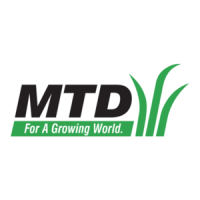
Do you have a question about the MTD 90 Series and is the answer not in the manual?
Explains the purpose of the manual for service dealers.
Covers essential safety instructions for working with the equipment.
Details metric and fractional inch fasteners used on MTD engines.
Provides guidance on torque specs, lubricants, and assembly procedures.
Explains how to locate and interpret engine model and serial numbers.
Discusses basic maintenance practices for engine longevity.
Explains the function, types, and maintenance of air filters.
Specifies recommended oil types, capacities, and checking procedures.
Details the procedure for draining and refilling engine oil.
Discusses fuel types, alcohol content, and storage best practices.
Explains the function and location of fuel filters.
Describes how to check and adjust valve lash for optimal engine performance.
Provides instructions for cleaning the engine to maintain operating temperature.
Lists torque specifications for various fasteners.
Outlines a schedule for routine engine maintenance tasks.
Summarizes key engine specifications for quick reference.
Defines key terms like Troubleshooting and Diagnosis.
Introduces the principles of engine diagnosis.
Outlines a systematic approach to diagnosing engine problems.
Explains the first step in troubleshooting: clearly identifying the issue.
Guides on identifying potential causes for engine malfunctions.
Describes a test to isolate fuel system issues.
Explains how to perform a leak-down test for compression issues.
Details how to conduct a compression test for engine health.
Covers testing the Positive Crankcase Ventilation system.
Explains the function and removal/installation of the heat box.
Details the types, maintenance, and replacement of air filters.
Covers the removal and installation of the air filter base and control panel.
Describes the carburetor and insulator assembly, and their removal.
Provides guidance on inspecting fuel quality for issues.
Explains how to test fuel for alcohol content.
Discusses the function and testing of the fuel tank vent.
Details the location, cleaning, and replacement of the fuel filter.
Guides on inspecting fuel lines for cracks, clogs, or brittleness.
Covers the removal and installation of the fuel tank.
Explains the EVAP system and its components.
Provides steps for testing and troubleshooting the EVAP system.
Details how to test the function of the roll over valve.
Covers the removal and installation of the charcoal canister.
Describes the removal and installation of the roll over valve.
Explains choke operation and adjustment.
Details how to test and replace the primer for snow engines.
Covers inspection, disassembly, and rebuilding of carburetors.
Describes servicing the fuel shut-off valve on the carburetor.
Explains the function of the governor in controlling engine speed.
Details the removal and installation of the governor arm.
Covers the removal and replacement of the governor shaft.
Explains servicing the governor cup and gear assembly.
Details the procedure for adjusting the governor.
Specifies recommended oil types, grades, and capacities.
Explains how to check the oil level using different dipstick types.
Details the procedure for removing and replacing the dipstick tube.
Describes the engine's splash lubrication system.
Covers the removal, inspection, and reassembly of the PCV valve.
Explains how to remove the recoil starter assembly.
Details inspection, removal, and installation of the starter cup.
Covers common failure modes and replacement of the starter rope.
Describes disassembly and inspection of the starter pulley and recoil spring.
Explains the operation and replacement of the electric starter.
Describes the components of the engine's charging system.
Guides on testing the charging system's voltage output.
Covers the removal, installation, and testing of the stator.
Explains how to check the rotor for damage.
Provides steps for diagnosing ignition system problems.
Details how to test the throttle-mounted stop switch.
Explains how to test the remote stop switch found on snow engines.
Guides on diagnosing issues where the engine fails to shut off.
Discusses the ignition module, its function, and performance expectations.
Covers the steps for removing the ignition module.
Details the process of installing the module and setting the spark gap.
Covers flywheel removal, inspection, and installation, including the keyway.
Provides information on the recommended spark plug and its specifications.
Discourages spark plug cleaning and recommends replacement.
Explains how spark plug inspection indicates engine condition.
Details the procedure for removing and installing spark plugs.
Notes differences in exhaust systems between summer and snow engines.
Covers the inspection, cleaning, and replacement of the spark arrestor.
Details the removal and installation of the muffler and manifold pipe.
Covers the removal and replacement of the muffler on snow engines.
Provides steps for removing the cylinder head.
Details the procedure for installing the cylinder head.
Explains how to service valves, including removal and inspection.
Covers inspection of crankshaft journals, crank pin, and run out.
Details piston cleaning, ring gap measurement, and piston pin bore checks.
Guides on inspecting the connecting rod for damage and measuring clearances.
Covers cleaning, inspection, and measurement of the cylinder bore and cross hatch.
Explains the function of the balance shaft in reducing engine vibrations.
Provides detailed steps for engine reassembly.
Lists various engine specifications and service limits.
Provides a chart of torque values for engine fasteners.
Explains how abrasive particles enter the engine and cause wear.
Discusses failures related to lack of proper lubrication.
Covers issues arising from the engine exceeding its maximum speed.
Explains how overheating affects engine parts and performance.
Discusses failures due to part breakage, wear, abuse, or defects.
Explains conditions causing premature fuel combustion in the cylinder.
